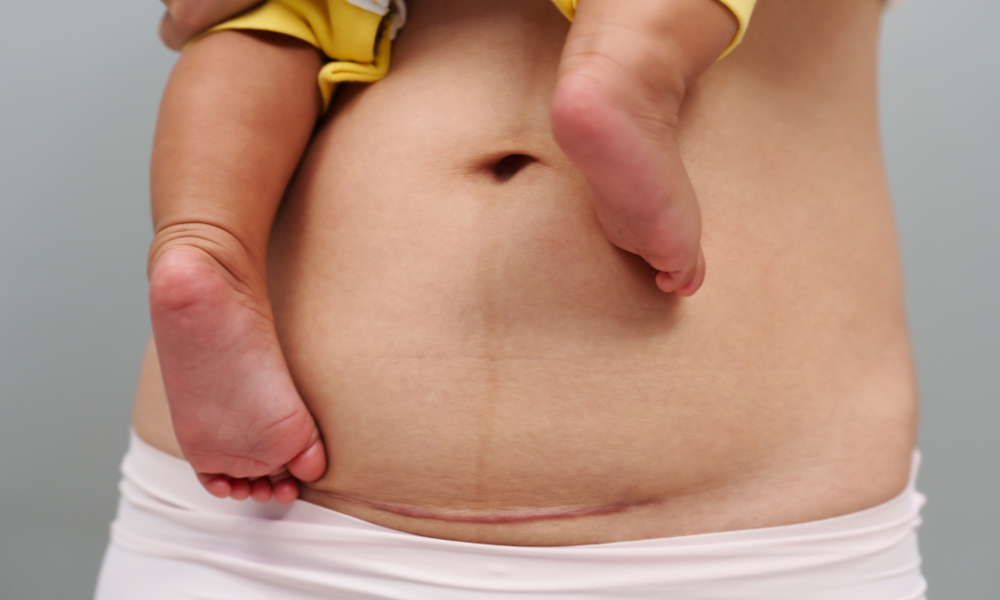C-Section Scar Pain & Complications
Move Better. Live Fuller. Your Wellness Journey Starts Here.
Schedule a FREE Discovery Call!
What Is a Cesarean Section?
A cesarean section or c-section is a common procedure used for childbirth that utilizes an incision through the abdominals and uterus to deliver a baby.
Although c-sections can be necessary for some individuals and may provide a safer alternative to vaginal delivery, it does affect many layers of skin, muscle, and other tissues, which can create complications.
These complications are typically caused by the disruption to these tissues. The surgical incision can impair abdominal or pelvic floor function, create restrictive scar tissue, reduce mobility, alter posture, and affect overall comfort. These complications are worsened by additional factors such as hormonal changes and other effects experienced during pregnancy.
Some examples of complications often created by cesarean sections include:

Scar Tissue Restriction
One obvious aspect of experiencing a c-section is the scar tissue that forms as a result. This scar tissue can be restrictive and may limit mobility or cause tightness at the incision site. This scar tissue can affect the mobility of the abdominal wall, and may indirectly affect the pelvic floor and other areas of the body. Some individuals may experience sensitivity, discomfort, or even pain from tight scar tissue, which can disrupt daily activities.
Abdominal Dysfunction
The incision performed to the abdominals does more than create scar tissue. It affects the function and strength of the abdominal muscles, too. This impacts core function that is necessary for movement, and can contribute to pelvic or back pain.
The weakened core muscles may struggle to perform simple activities or exercises, which can disrupt daily life postpartum. For example, bending over or lifting items, even light things, can be more difficult or uncomfortable. Even your walking patterns may be affected by abdominal tightness or pelvic floor dysfunction—which we’ll discuss next.
Pelvic Floor Dysfunction
The pelvic floor is significantly affected by pregnancy, even for individuals who require a cesarean. While core weakness and scar tissue can affect the pelvic floor, the pregnancy itself puts excess pressure and strain on the pelvic floor for many months, which can weaken those muscles and cause pelvic floor dysfunction.
This dysfunction can cause incontinence, constipation, painful sex, and other unideal symptoms. For some, pelvic floor dysfunction can lead to symptoms of prolapse. This is often created by a mixture of pelvic floor strain and weakness.
It is important to recognize that not all individuals who undergo a c-section plan to do so ahead of time. Many individuals attempt vaginal delivery first, which puts additional strain and pressure on the pelvic floor. Even with the absence of vaginal delivery, the loss of core strength and coordination from a cesarean still affects the pelvic floor—creating strain, discomfort, and poor function.
Other Pain and Discomfort
There are many other factors caused by pregnancy or cesarean delivery that can lead to pain and discomfort, such as the following:
- Postural changes or misalignment: Poor posture or spinal misalignment can cause pelvic pain, hip pain, back pain, or pelvic girdle pain. This pain is often worsened by compensatory patterns, which are movements or postures developed in response to pain. This is especially so if individuals have poor posture during movements such as lifting—which may be more difficult with c-section scar tissue.
- Breathing dysfunctions: Poor posture and low core coordination can lead to breathing dysfunctions as your core muscles and diaphragm struggle to coordinate.
- Nerve compression: Lastly, pelvic floor dysfunction or misalignment may cause nerve irritation or compression—which can create pain and discomfort in the back, pelvis, or hips.
Why Would Someone Need a Cesarean Section?
There are many reasons why an individual may need a cesarean section. In some cases, an individual may know of their need for a c-section ahead of time. Others, especially with first-time deliveries, may not have the need for a c-section until labor has already started. Below, we’ve outlined some scenarios in which a cesarean may be necessary:
Health Concerns
In some cases, the need for a cesarean is determined ahead of time. This is common with pre-existing conditions such as severe prolapse, pelvic deformities, previous birth traumas or surgeries, high blood pressure, heart disease, or infections.
In other cases, vaginal delivery may be attempted first, but disrupted by complications such as obstructed labor, fetal distress, unsafe fetal positions, or multiple pregnancies.
Complications
In some cases, the act of labor itself may present complications that make a cesarean necessary. This can involve issues such as blockage by the placenta, premature placental separation, or even prolonged labor. In other cases, emergencies such as umbilical cord prolapse or hemorrhage may make an immediate c-section necessary.
Request
Although less common, some individuals choose to have a c-section even in the absence of a medical need. This can be due to a fear associated with labor, vaginal trauma, or prior traumatic experiences with childbirth. Other personal preferences or considerations may also affect this decision.
Physical Therapy For C-Section Prep and Recovery
Pelvic floor physical therapy plays a very important role in the preparation and recovery of cesarean delivery. By engaging in physical therapy during pregnancy and after delivery, you’ll reduce your risk of complications and improve your healing outcomes.
Pelvic floor physical therapy looks to improve core strength, pelvic floor health, and mobility for those who will experience or have experienced a cesarean. This involves treatments to relieve pain, restore function, and improve posture so that you can live and move comfortably postpartum. Some treatments used at Hive Therapy and Wellness include:
Core Strengthening & Posture
Your pelvic floor therapist can address core strength and function both before and after delivery. Core strength is necessary to support practically any movement, such as walking, bending over, turning over, lifting, and more. To support good function and comfort of your core muscle groups, your physical therapist will lead you through exercises that align with your capabilities either during pregnancy or while healing postpartum.
This can include core strengthening exercises, diaphragmatic breathing strategies, and practicing proper form or posture. Your physical therapist won’t only focus on your core and abdominal muscles, but also your hips, back, and pelvis, too.
For those recovering postpartum, your physical therapist will gradually reintroduce different movements and activities to help you properly engage your muscles and maintain posture while walking, lifting, bending over, and more.
You can expect to engage in stretching exercises for many areas of the body, which will further support proper core function and movement. This will improve your flexibility and encourage better mobility for your abdominals. With these improvements, you can expect a decrease in abdominal or pelvic tension, which can help reduce pain, support function, and improve comfort.
Pelvic Floor Training
Pelvic floor training is absolutely essential for pregnancy and childbirth, regardless of the type of delivery you experience. This is because your pelvic floor plays a major role in supporting your body’s balance and stability, protecting your pelvic organs, and allowing for daily functions—like using the restroom and enjoying sexual activities.
It also directly supports your body’s changes during pregnancy, and is directly involved in vaginal delivery. The pelvic floor supports your core health too, so the health of this muscle group shouldn’t be ignored for those who undergo a cesarean!
The pelvic floor is very interconnected with the abdominals, so having a healthy pelvic floor is important for supporting your body’s core engagement and daily movements. For example, the core coordinates with your pelvic floor so that you can walk, bend over, lift items, jump, and enjoy daily life without pain.
To enhance your pelvic floor health, your pelvic floor therapist will first identify any imbalances in your pelvic floor, such as weakness, tightness, or a lack of coordination. These dysfunctions of the pelvic floor are common, especially during pregnancy or postpartum.
To address these dysfunctions, they’ll lead you through a variety of exercises, relaxation practice, coordination activities, and more! These treatments will help address a variety of pelvic floor problems such as incontinence, pelvic pain, painful sex, and more.
Feel free to check out this other article on childbirth preparation to learn more about how pelvic floor physical therapy can support your delivery experience—whether it be vaginal or cesarean!
Pain Management and Scar Mobility
Hive offers a variety of pain relieving treatments, which can be very useful postpartum (and for some techniques, during pregnancy, too). After all, many individuals experience pain in multiple areas of the body due to the effects of pregnancy and childbirth.
To address these bodily pains, Hive can provide manual therapies to release tight tissues, mobilize nerves and other structures, improve blood flow, and enhance mobility. These treatments can be utilized for many areas of the body, such as the back, hips, and pelvis. Your physical therapist will be sure to address any harmful postures or movement mechanics that may be worsening your pain and muscle tension in these areas.
As mentioned earlier, scar tissue from c-sections can be very restrictive and even painful. Therefore, postpartum individuals can expect to engage in manual therapies for their scar tissue too, which will help improve mobility, increase comfort, and encourage desensitization. Improved scar mobility is great not just for the incision area itself, but also for supporting overall core movement and function.
Behavioral Modifications
Some behaviors, such as your posture, movements, and breathing patterns can affect your abdominal health and may worsen postpartum symptoms after a cesarean section. Your pelvic floor therapist will evaluate your posture, alignment, body mechanics, and breathing patterns to check for any areas needing improvement.
Having good posture is very important during pregnancy and postpartum in order to support proper core function and breathing patterns. Your physical therapist will improve your general postural alignment as well as your posture during specific movements or activities. Enhancing your spinal alignment and posture will prevent strain or pressure on your core, pelvis, and cesarean incision site.
Depending on your individual needs, your physical therapist may teach you diaphragmatic breathing techniques that will help improve coordination of the pelvic floor and diaphragm, as well as reduce tension in the core muscle groups.
Education and More
Lastly, your pelvic floor therapist will educate you on at-home care: Managing pain, massaging scar tissue, exercises, stretching, posture, breathing strategies, and more. While treatment at the clinic is very beneficial, practicing these strategies at home is just as important!
In addition to physical at-home strategies, Hive’s physical therapists can help educate you on all types of topics, such as pelvic floor anatomy, core health, pregnancy changes, postpartum healing, and more. Hive’s physical therapists are experts of the body, and have supported many people through their pregnancy and postpartum healing journeys. While working with our providers, feel free to share your concerns or ask questions as needed—they’re here to help, and are happy to share their knowledge with you!
Our physical therapists work hard to provide individualized and holistic treatment that best meets your unique needs. As a part of your comprehensive care plan, your physical therapist may utilize any of the following:
- Neuromuscular re-education
- Manual therapy
- Exercise prescription
- Dry needling
- Cupping
- Tissue scraping
- Behavioral modifications
- Therapeutic activities
- Electrical muscle stimulation
- Spinal manipulation
- Therapeutic modalities
- Biofeedback
A cesarean section or c-section is a common procedure used for childbirth that utilizes an incision through the abdominals and uterus to deliver a baby.
Although c-sections can be necessary for some individuals and may provide a safer alternative to vaginal delivery, it does affect many layers of skin, muscle, and other tissues, which can create complications.
These complications are typically caused by the disruption to these tissues. The surgical incision can impair abdominal or pelvic floor function, create restrictive scar tissue, reduce mobility, alter posture, and affect overall comfort.
These complications are worsened by additional factors such as hormonal changes and other effects experienced during pregnancy.
Some examples of complications often created by cesarean sections include:
Scar Tissue Restriction
One obvious aspect of experiencing a c-section is the scar tissue that forms as a result. This scar tissue can be restrictive and may limit mobility or cause tightness at the incision site.
This scar tissue can affect the mobility of the abdominal wall, and may indirectly affect the pelvic floor and other areas of the body. Some individuals may experience sensitivity, discomfort, or even pain from tight scar tissue, which can disrupt daily activities.
Abdominal Dysfunction
The incision performed to the abdominals does more than create scar tissue. It affects the function and strength of the abdominal muscles, too. This impacts core function that is necessary for movement, and can contribute to pelvic or back pain.
The weakened core muscles may struggle to perform simple activities or exercises, which can disrupt daily life postpartum. For example, bending over or lifting items, even light things, can be more difficult or uncomfortable.
Even your walking patterns may be affected by abdominal tightness or pelvic floor dysfunction—which we’ll discuss next.
Pelvic Floor Dysfunction
The pelvic floor is significantly affected by pregnancy, even for individuals who require a cesarean.
While core weakness and scar tissue can affect the pelvic floor, the pregnancy itself puts excess pressure and strain on the pelvic floor for many months, which can weaken those muscles and cause pelvic floor dysfunction.
This dysfunction can cause incontinence, constipation, painful sex, and other unideal symptoms. For some, pelvic floor dysfunction can lead to symptoms of prolapse. This is often created by a mixture of pelvic floor strain and weakness.
It is important to recognize that not all individuals who undergo a c-section plan to do so ahead of time. Many individuals attempt vaginal delivery first, which puts additional strain and pressure on the pelvic floor.
Even with the absence of vaginal delivery, the loss of core strength and coordination from a cesarean still affects the pelvic floor—creating strain, discomfort, and poor function.
Other Pain and Discomfort
There are many other factors caused by pregnancy or cesarean delivery that can lead to pain and discomfort, such as the following:
- Postural changes or misalignment: Poor posture or spinal misalignment can cause pelvic pain, hip pain, back pain, or pelvic girdle pain. This pain is often worsened by compensatory patterns, which are movements or postures developed in response to pain. This is especially so if individuals have poor posture during movements such as lifting—which may be more difficult with c-section scar tissue.
- Breathing dysfunctions: Poor posture and low core coordination can lead to breathing dysfunctions as your core muscles and diaphragm struggle to coordinate.
- Nerve compression: Lastly, pelvic floor dysfunction or misalignment may cause nerve irritation or compression—which can create pain and discomfort in the back, pelvis, or hips.
There are many reasons why an individual may need a cesarean section. In some cases, an individual may know of their need for a c-section ahead of time.
Others, especially with first-time deliveries, may not have the need for a c-section until labor has already started. Below, we’ve outlined some scenarios in which a cesarean may be necessary:
Health Concerns
In some cases, the need for a cesarean is determined ahead of time. This is common with pre-existing conditions such as severe prolapse, pelvic deformities, previous birth traumas or surgeries, high blood pressure, heart disease, or infections.
In other cases, vaginal delivery may be attempted first, but disrupted by complications such as obstructed labor, fetal distress, unsafe fetal positions, or multiple pregnancies.
Complications
In some cases, the act of labor itself may present complications that make a cesarean necessary.
This can involve issues such as blockage by the placenta, premature placental separation, or even prolonged labor. In other cases, emergencies such as umbilical cord prolapse or hemorrhage may make an immediate c-section necessary.
Request
Although less common, some individuals choose to have a c-section even in the absence of a medical need.
This can be due to a fear associated with labor, vaginal trauma, or prior traumatic experiences with childbirth. Other personal preferences or considerations may also affect this decision.
Pelvic floor physical therapy plays a very important role in the preparation and recovery of cesarean delivery. By engaging in physical therapy during pregnancy and after delivery, you’ll reduce your risk of complications and improve your healing outcomes.
Pelvic floor physical therapy looks to improve core strength, pelvic floor health, and mobility for those who will experience or have experienced a cesarean.
This involves treatments to relieve pain, restore function, and improve posture so that you can live and move comfortably postpartum. Some treatments used at Hive Therapy and Wellness include:
Core Strengthening & Posture
Your pelvic floor therapist can address core strength and function both before and after delivery. Core strength is necessary to support practically any movement, such as walking, bending over, turning over, lifting, and more.
To support good function and comfort of your core muscle groups, your physical therapist will lead you through exercises that align with your capabilities either during pregnancy or while healing postpartum.
This can include core strengthening exercises, diaphragmatic breathing strategies, and practicing proper form or posture. Your physical therapist won’t only focus on your core and abdominal muscles, but also your hips, back, and pelvis, too.
For those recovering postpartum, your physical therapist will gradually reintroduce different movements and activities to help you properly engage your muscles and maintain posture while walking, lifting, bending over, and more.
You can expect to engage in stretching exercises for many areas of the body, which will further support proper core function and movement.
This will improve your flexibility and encourage better mobility for your abdominals. With these improvements, you can expect a decrease in abdominal or pelvic tension, which can help reduce pain, support function, and improve comfort.
Pelvic Floor Training
Pelvic floor training is absolutely essential for pregnancy and childbirth, regardless of the type of delivery you experience.
This is because your pelvic floor plays a major role in supporting your body’s balance and stability, protecting your pelvic organs, and allowing for daily functions—like using the restroom and enjoying sexual activities.
It also directly supports your body’s changes during pregnancy, and is directly involved in vaginal delivery. The pelvic floor supports your core health too, so the health of this muscle group shouldn’t be ignored for those who undergo a cesarean!
The pelvic floor is very interconnected with the abdominals, so having a healthy pelvic floor is important for supporting your body’s core engagement and daily movements.
For example, the core coordinates with your pelvic floor so that you can walk, bend over, lift items, jump, and enjoy daily life without pain.
To enhance your pelvic floor health, your pelvic floor therapist will first identify any imbalances in your pelvic floor, such as weakness, tightness, or a lack of coordination. These dysfunctions of the pelvic floor are common, especially during pregnancy or postpartum.
To address these dysfunctions, they’ll lead you through a variety of exercises, relaxation practice, coordination activities, and more! These treatments will help address a variety of pelvic floor problems such as incontinence, pelvic pain, painful sex, and more.
Feel free to check out this other article on childbirth preparation to learn more about how pelvic floor physical therapy can support your delivery experience—whether it be vaginal or cesarean!
Pain Management and Scar Mobility
Hive offers a variety of pain relieving treatments, which can be very useful postpartum (and for some techniques, during pregnancy, too). After all, many individuals experience pain in multiple areas of the body due to the effects of pregnancy and childbirth.
To address these bodily pains, Hive can provide manual therapies to release tight tissues, mobilize nerves and other structures, improve blood flow, and enhance mobility.
These treatments can be utilized for many areas of the body, such as the back, hips, and pelvis. Your physical therapist will be sure to address any harmful postures or movement mechanics that may be worsening your pain and muscle tension in these areas.
As mentioned earlier, scar tissue from c-sections can be very restrictive and even painful. Therefore, postpartum individuals can expect to engage in manual therapies for their scar tissue too, which will help improve mobility, increase comfort, and encourage desensitization.
Improved scar mobility is great not just for the incision area itself, but also for supporting overall core movement and function.
Behavioral Modifications
Some behaviors, such as your posture, movements, and breathing patterns can affect your abdominal health and may worsen postpartum symptoms after a cesarean section.
Your pelvic floor therapist will evaluate your posture, alignment, body mechanics, and breathing patterns to check for any areas needing improvement.
Having good posture is very important during pregnancy and postpartum in order to support proper core function and breathing patterns.
Your physical therapist will improve your general postural alignment as well as your posture during specific movements or activities. Enhancing your spinal alignment and posture will prevent strain or pressure on your core, pelvis, and cesarean incision site.
Depending on your individual needs, your physical therapist may teach you diaphragmatic breathing techniques that will help improve coordination of the pelvic floor and diaphragm, as well as reduce tension in the core muscle groups.
Education and More
Lastly, your pelvic floor therapist will educate you on at-home care: Managing pain, massaging scar tissue, exercises, stretching, posture, breathing strategies, and more. While treatment at the clinic is very beneficial, practicing these strategies at home is just as important!
In addition to physical at-home strategies, Hive’s physical therapists can help educate you on all types of topics, such as pelvic floor anatomy, core health, pregnancy changes, postpartum healing, and more.
Hive’s physical therapists are experts of the body, and have supported many people through their pregnancy and postpartum healing journeys.
While working with our providers, feel free to share your concerns or ask questions as needed—they’re here to help, and are happy to share their knowledge with you!
Our physical therapists work hard to provide individualized and holistic treatment that best meets your unique needs. As a part of your comprehensive care plan, your physical therapist may utilize any of the following:
- Neuromuscular re-education
- Manual therapy
- Exercise prescription
- Dry needling
- Cupping
- Tissue scraping
- Behavioral modifications
- Therapeutic activities
- Electrical muscle stimulation
- Spinal manipulation
- Therapeutic modalities
- Biofeedback
You can learn more about these treatments on our Treatments Page.





